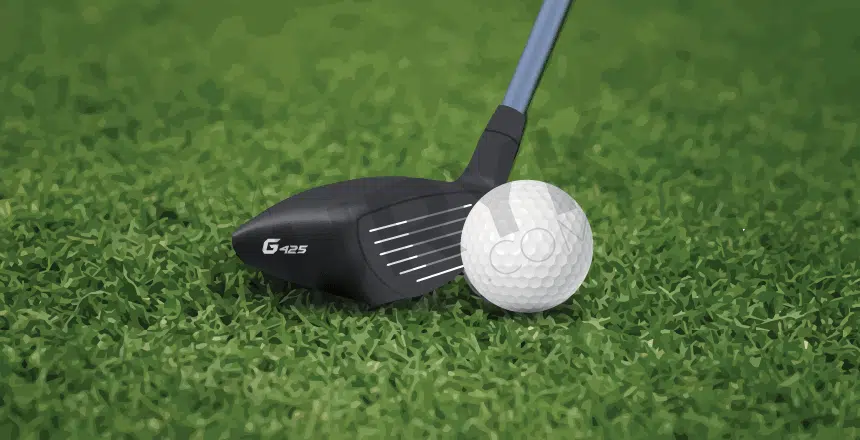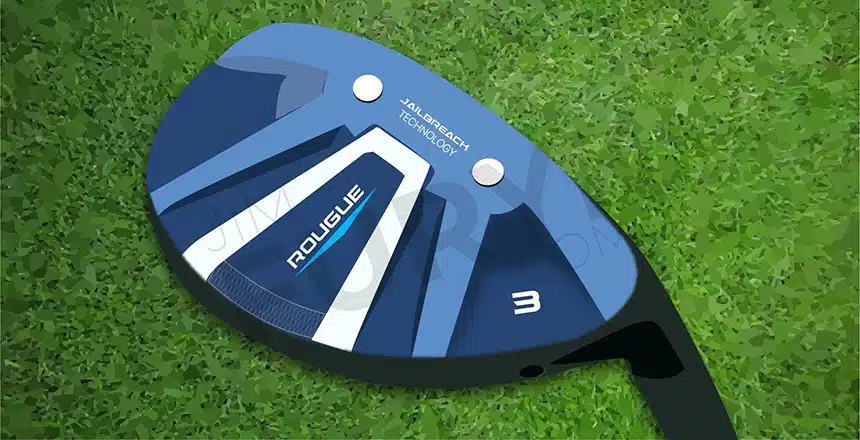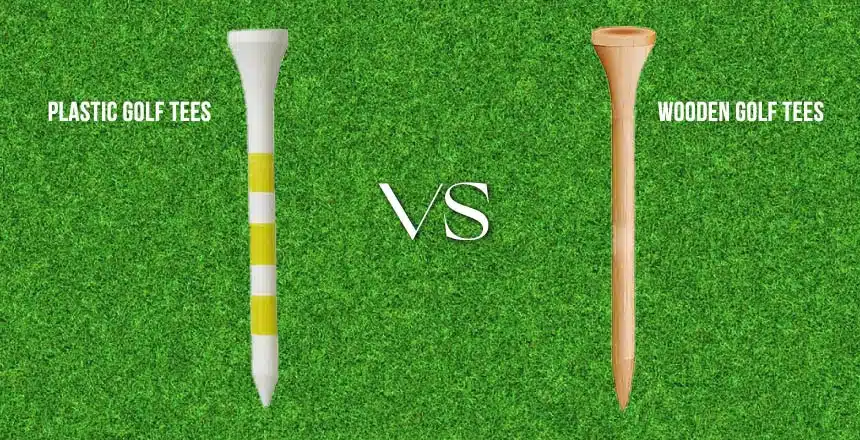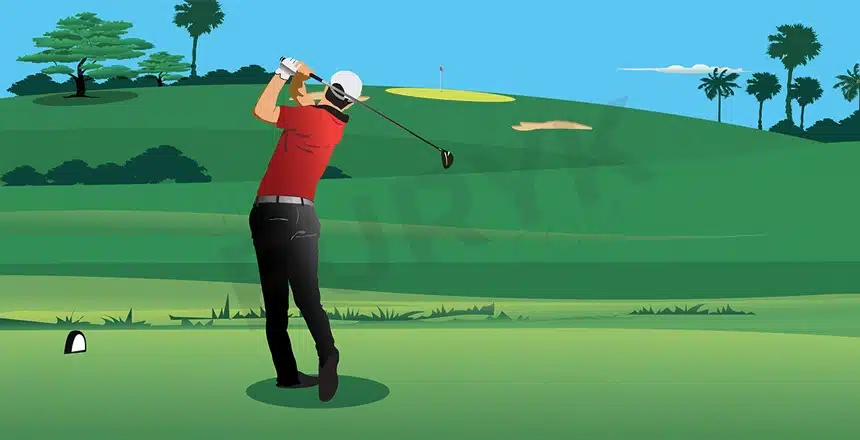Choose the right club, and you will surely win half of the game. However, many beginners don’t know which club to choose between fairway woods vs. hybrids.
The main difference between these clubs is that the fairway wood has a wider head and sole, allowing you to hit further with a flatter trajectory. Meanwhile, a hybrid is more forgiving and simpler to strike.
This side-by-side comparison will explain how fairway woods and hybrids differ. Let’s read on to discover!
In This Post
What Are Fairway Woods?

Fairway woods are fantastic for attacking a par five from a very long distance. I often choose it to play safe off the tee.
They help me gain much confidence in the driver. I also find them more effective in the wind since they strike the ball lower.
However, because of their lower trajectory and limited spin, these clubs are harder to hit than their competitors, especially when I hold the green.
What Are Hybrids?

Hybrids are highly user-friendly and flexible clubs. When targeting the green from a distance on long par threes, I can strike them from the tee, out of the rough, and with a chip.
However, they spin so much in some cases. I don’t know how to control them entirely in the wind.
Differences Between Fairway Woods vs. Hybrids
Above is my experience playing in the two clubs. I will discuss their differences deeper in this section.
Construction
You can hit fairway wood more easily from spots other than the tee. However, its head is similar to that of a driver but smaller and yields higher lofts.
The fairway wood may be the club with the longest shaft in your club bag. Thanks to this feature, it can help you with your approach and golf swing.
Although its head is smaller than the driver’s, it’s still bigger and has lower lofts when compared to the hybrid. The big head can sweep across the green and launch at a low angle.
A club with a low loft and contact will make your shots longer, making it an excellent choice for accurate tee shots.
On the other hand, a hybrid’s shaft is shorter, and its head is smaller than a fairway wood. This feature helps it cut through the rough easier and fly higher.
Because of their deep club head, many golfers use a hybrid to replace their long irons. This shape distributes the weight evenly and strengthens the contact for your hit off-center.
Moreover, a hybrid’s sweet spot is bigger, and its face is more forgiving than a fairway wood.
Large fairway wood divots are frequently a sign of an overly steep swing. However, a divot isn’t always bad since a hybrid’s construction enables it to get underneath the ball smoothly.
Distance
Both fairway woods and hybrids come in different types, and each has a different distance. I will check all of them for the most detailed comparison.
Let’s start with the fairway woods first:
| Fairway wood | Beginner (yards) | Average (yards) | Good (yards) |
|---|---|---|---|
| 2-wood | 180 | 215 | 235 |
| 3-wood | 170 | 210 | 225 |
| 4-wood | 165 | 205 | 215 |
| 5-wood | 150 | 195 | 205 |
Fairwoods divide their distances depending on the golfer’s skill. Meanwhile, hybrids’ distance varies because of the golfer’s gender and speed.
| Hybrid | Distance for men (in yards) (Slow-Med-Fast) | Distance for women (in yards) (Slow-Med-Fast) |
|---|---|---|
| 1-hybrid | 194-226-245 | 115-151-194 |
| 2-hybrid | 176-205-222 | 104-137-176 |
| 3-hybrid | 163-189-205 | 96-126-163 |
| 4-hybrid | 154-179-194 | 91-119-145 |
| 5-hybrid | 145-168-183 | 85-112-145 |
| 6-hybrid | 136-158-171 | 80-105-136 |
| 7-hybrid | 127-147-160 | 75-98-127 |
| 8-hybrid | 118-137-148 | 69-91-118 |
| 9-hybrid | 104-121-131 | 61-81-104 |
You can check the distance charts to know which value corresponds to which distance. Depending on the swing speed for male and female golfers, it specifies the anticipated range for each club.
Wood and iron often correspond to the variable number of hybrids. You may have noticed that a hybrid resembles a tiny piece of wood.
After your research, you might uncover several hybrids versus fairway wood charts. However, the statistics don’t always line up because the golfer’s skills and range are more important factors.
Setup and swing
To perform a strike with a fairway wood, you need to place the ball close to the front of your stance, and the club head must brush the top of the grass.
You can also use this club on the tee, but remember to position it lower than you often do with a driver because of the wood’s smaller head.
Most players put the ball anywhere between barely off the ground and about one inch in the air. You can find the sweet spot yourself as it’s a personal preference.
If you hit from the fairway, place the ball toward your front foot. The best contact point is at your ball at a level angle. You may experience a divot with this method.
A golfer should make a level swing using the fairway wood. As your club pushes the ball off the course, the clubface ought to be parallel to the ground.
How about the hybrid? You can hit your hybrid the same way you would with your long iron. So, place the ball in the middle of your stance and point slightly toward your front foot. Do not take it too close, as you will hit down on your ball.
Unlike the wood, solid impact with a hybrid will lead to a little divot. You will chunk it if your divot is deep and large.
When using the hybrid to hit off the tee, consider it an iron. You may continue using a tee, but most golfers like to have it off the grass, far enough to allow you to contact the club’s core without digging too deeply.
Comparison table
We have compared the two clubs in important factors. Now, let’s summarize their differences!
| Criteria | Fairway Woods | Hybrids |
|---|---|---|
| Construction | – Head: bigger, bulging, and spherical – Shaft: longer | – Head: smaller, dense, and slight convex – Shaft: shorter and more flexible |
| Distance | – Beginner: 150 yards to 180 yards – Average: 195 to 215 yards – Good: 205 to 235 yards | Men: – Slow: 104 to 194 yards – Med: 121 to 226 yards – Fast: 131 to 245 yards Women: – Slow: 61 to 115 yards – Med: 81 to 151 yards – Fast: 104 to 194 yards |
| Setup and swing | – Setup: Place the ball close to the front of your stance – Swing: Level | – Setup: Place the ball in the middle of your stance – Swing: Steep |
| Pros | – Excellent for long-range strikes – Ability to withstand windy conditions | – Easy to use – Flexible (suitable to play from the fairway and the tee) |
| Cons | Harder to hit because of the decreased spin and lower flight | The more spin makes it hard to control under windy conditions |
Fairway Woods vs. Hybrids: When To Use?
Both clubs have pros and cons; however, you can choose the better one after considering your situation. Here are cases where one outperforms the other.
Beginners
Golf beginners should make things as simple as possible so they can have a good time and pick it up fast.
Hybrids are among the most straightforward clubs to play. They are excellent for beginner golfers’ bags.
Fairway woods are also helpful; many individuals will benefit from bringing a three wood rather than a driver. It will help you hit the driver and give you more time to do so.
Low to mid handicappers
The added length of a fairway wood may come in handy if you often face long tee shots when playing a long course.
On the other hand, a hybrid might be the ideal option if you play a game with small greens that promotes accuracy.
High handicappers
Working with one fairway wood and several hybrids is a simple solution for golfers with higher handicaps or who want to achieve a little extra distance.
Since fairway woods are more difficult to use and a 5-wood flies roughly the same range as a 3-hybrid, adding more fairway woods is not viable.
Hybrids make contact more often than clubs like 4, 5, and even 6-irons because they are lighter.
Simply put, don’t bring clubs you aren’t sure you can use. Packing a 7-hybrid or higher is advisable if you find it necessary.
Low swing speed
With a hybrid, slow swing speeds will be more effective. It offers a high launch angle and maximum spin in mind.
For golfers with slower swings, getting fairway woods can be more challenging.
This video also recommends some cases to use the clubs. Please check to have more ideas about choosing the right tool for your course:
Frequently Asked Questions
1. What hybrid would replace a 3-wood?
A 3-wood has a pitch of roughly 15 degrees, making it stronger than most hybrids available as they go no lower than 16 degrees.
In general, a 16-degree hybrid won’t travel as far as a 3-wood, but you might make up for that lost distance with better control and accuracy.
2. Do hybrid clubs replace fairway woods?
Yes. A hybrid can substitute a fairway wood with a similar loft.
For instance, a golfer might interchangeably use a 3-iron and a 5-wood depending on the score they aim for and the course condition.
3. Is it better to have a 3-wood or 3-hybrid?
Most golfers require the extra distance a 3-wood can offer.
The 3-wood is often easier to hit farther, but it might not be as accurate as a 3-hybrid. Ideally, you can carry both for your game.
4. What’s better off the tee?
A hybrid is better for accuracy and control. Yet, a fairway wood, especially the 3-wood, can help you with the distance. So both clubs are helpful.
5. What’s better from the fairway?
The fairway wood can fly farther from the fairway but at the cost of being a little more difficult to hit. Yet, it’ll still be a good choice if you prioritize the distance.
The Bottom Line
Fairway Woods vs Hybrids – What are the differences?
After all, a fairway wood is a better option for distance. You will also find it easier to use, making it an ideal choice for beginners.
On the other hand, if control and accuracy are what you need to improve your game, a hybrid will be a big help.
Hopefully, you can choose the best tool for your next course after reading this post. If you have any questions, please feel free to ask. Thank you for reading!




